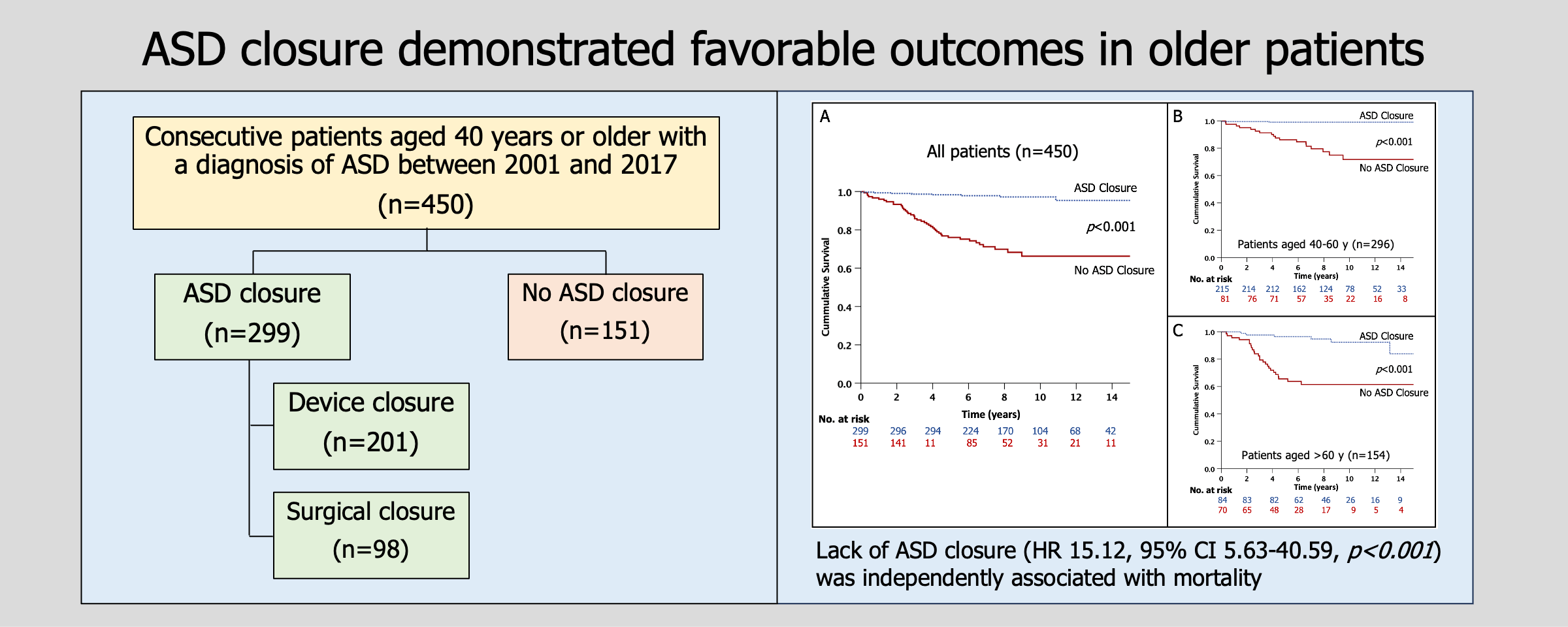 Open Access
Open Access
ARTICLE
Impact of Atrial Septal Defect Closure on Mortality in Older Patients
1 Division of Cardiology, Department of Medicine, Faculty of Medicine Siriraj Hospital, Mahidol University, Bangkok, Thailand
2 Her Majesty Cardiac Center, Faculty of Medicine Siriraj Hospital, Mahidol University, Bangkok, Thailand
3 Department of Medicine, Faculty of Medicine Siriraj Hospital, Mahidol University, Bangkok, Thailand
* Corresponding Author: Nithima Ratanasit. Email:
Congenital Heart Disease 2024, 19(1), 93-105. https://doi.org/10.32604/chd.2024.048631
Received 13 December 2023; Accepted 29 January 2024; Issue published 20 March 2024
Abstract
Background: Atrial septal defect (ASD) is a common form of adult congenital heart disease that can lead to long-term adverse outcomes if left untreated. Early closure of ASD has been associated with excellent outcomes and lower complication rates. However, there is limited evidence regarding the prognosis of ASD closure in older adults. This study aims to evaluate the mortality rates in older ASD patients with and without closure. Methods: A retrospective cohort study was conducted on patients aged 40 years or older with ASD between 2001 and 2017. Patients were followed up to assess all-cause mortality. Univariable and multivariable analyses were performed to identify the predictors of mortality. A p-value of <0.05 was considered statistically significant. Results: The cohort consisted of 450 patients (mean age 56.6 ± 10.4 years, 77.3% female), with 66% aged between 40 and 60 years, and 34% over 60 years. Within the cohort, 299 underwent ASD closure (201 with transcatheter and 98 with surgical closure). During the median follow-up duration of 7.9 years, 51 patients died. The unadjusted cumulative 10-year rate of mortality was 3% in patients with ASD closure, and 28% in patients without ASD closure (log-rank p < 0.001). Multivariable analysis revealed that age (hazard ratio [HR] 1.04, 95% confidence interval [CI] 1.006–1.06, p = 0.01), NYHA class (HR 2.75, 95% CI 1.63–4.62, p < 0.001), blood urea nitrogen (BUN) (HR 1.07, 95% CI 1.03–1.12, p < 0.001), right ventricular systolic pressure (RVSP) (HR 1.07, 95% CI 1.003–1.04, p = 0.01), and lack of ASD closure (HR 15.12, 95% CI 5.63–40.59, p < 0.001) were independently associated with mortality. Conclusion: ASD closure demonstrated favorable outcomes in older patients. Age, NYHA class, BUN, RVSP, and lack of ASD closure were identified as independent factors linked to mortality in this population.Graphic Abstract

Keywords
Cite This Article
 Copyright © 2024 The Author(s). Published by Tech Science Press.
Copyright © 2024 The Author(s). Published by Tech Science Press.This work is licensed under a Creative Commons Attribution 4.0 International License , which permits unrestricted use, distribution, and reproduction in any medium, provided the original work is properly cited.


 Submit a Paper
Submit a Paper Propose a Special lssue
Propose a Special lssue View Full Text
View Full Text Download PDF
Download PDF Downloads
Downloads
 Citation Tools
Citation Tools